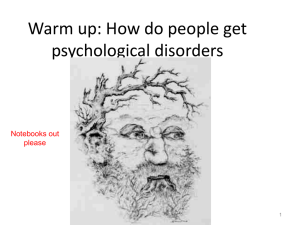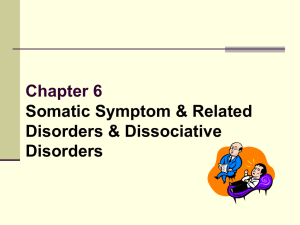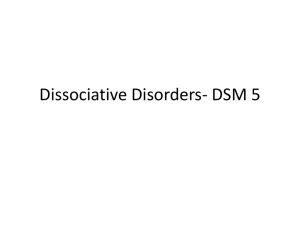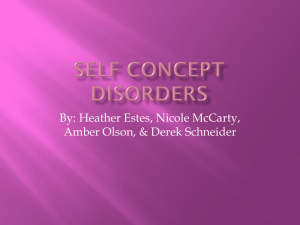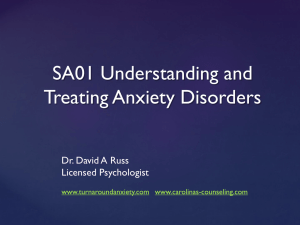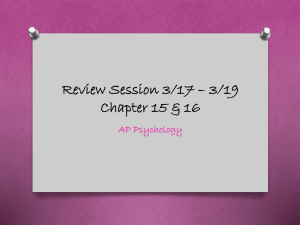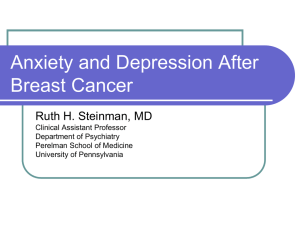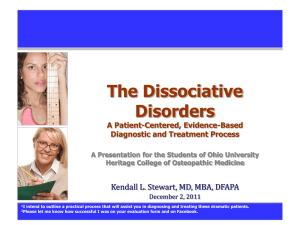2- obsessive compulsive disorders DSM 5
advertisement
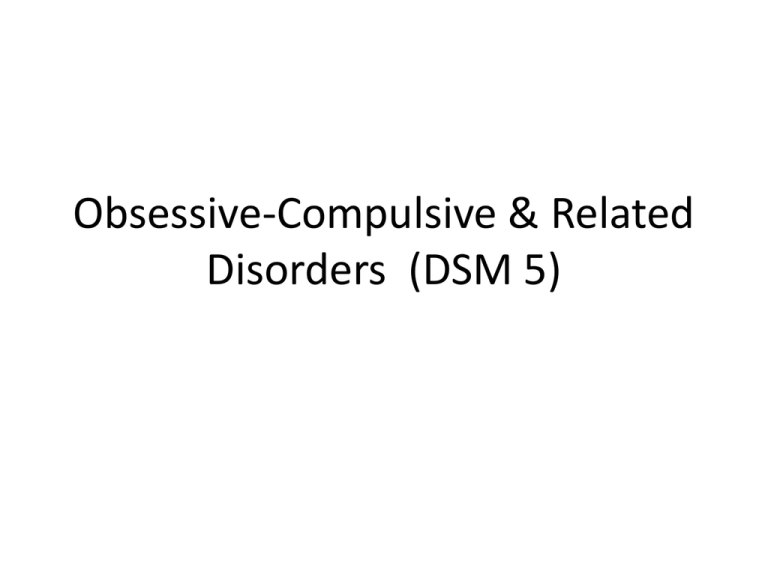
Obsessive-Compulsive & Related Disorders (DSM 5) • • • • • Obsessive – compulsive disorder Body dysmorphic disorder Hoarding disorder Trichotillomania (hair pulling) disorder Excoriation (skin picking) disorder Obsessive-Compulsive Disorder Obsessive Compulsive disorder • Either obsession or compulsion or both and as defined by: – Obsessions: • The preoccupation with recurrent and persistent thoughts , urges or images that are experienced- at some time during the disturbance- as being intrusive, senseless and unwanted and cause marked anxiety (obsession). – Not excessive worry about daily life problems. • The individual tries to cope with it by ignoring or suppressing such thoughts, urges or images or try to neutralize them with some other thought or action (i.e., performing a compulsion) • The person recognizes that the thoughts and images are of ones own mind not imposed on him. 5 OCD – Compulsion • Repetitive behavior (e.g., hand washing, ordering things …etc) or mental acts (e.g., praying, counting, repeating words silently) that the individual feels driven to perform as a response to an obsession or according to rules that must be followed rigidly. • The behaviors or mental acts are aimed at preventing or reducing anxiety or distress or preventing some dreaded event or situation; however, these behaviors or mental acts are not connected in a realistic way with what they are designed to neutralized or prevent or are clearly excessive 6 OCD • The obsessions or compulsion are time consuming (take more than 1 hour per day) or cause clinically significant distress or impairment in social, occupational or other important areas of functioning • The OCD symptoms are not attributable to the physiological effects of a substance (drug abuse or medication) or another medical disorder • The disturbance is not explained by symptoms of another mental disorder Specification of OCD • Specify be: – With good or fair insight: obsessive beliefs not true – With poor insight: obsessive belief probably true – With absent insight/ delusional beliefs: be;iefs & compulsions really true • Specify by: – Tic-related: person has currently or past tic disorder OCD • • • • • • • • Checking …………………………..63% Washing ………………….….……50% Contamination…………….…….45% Doubting……………………….…..42% Body fears………................... 36% Counting……………………..…….36% Insisting on symmetry……….. 31% aggressive behaviors ………..28% Body Dysmorphic Disorder Body Dysmorphic Disorder • A. Preoccupation with one or more perceived deficits or flaws in physical appearance that are not observable or appear slight to others • B. At some point the course of the disorder, the individual has performed repetitive behaviors (mirror checking, excessive grooming, skin picking, reassurance seeking) or mental acts (comparing his or her appearance with that of others) in response to the appearance concerns Body Dysmorphic Disorder • C. The preoccupation causes clinically significant distress of impairment in social, occupational or other important functioning • D. The appearance preoccupation is not explained by concerns of body fat or weight in an individual whose symptoms meeting diagnostic criteria for an eating disorder OCD • Mr. Adham a 28 year old cook at a resturent presents to the ER worried that his chapped hands may have become infected. • Mr. Adham has been obsessed with thoughts of infection and spends several hours each day scrubbing his hands each time he touches the kitchen tools. He said “ I am so distressed from these thoughts and it is making it difficult for me to do my work, I am missing a lot of days at work and I got fired”. Mr. Adham also admitted that he is being afraid of leaving the stove on accidently (obsession) and he checks his stove 29 times before leaving the house or going to bed (compulsion), Mr. Adham acknowledges that his behavior is senseless but is unable to control it • Physical exam: severely damaged skin with mild bleeding over both hands. • Normal tests Nursing Diagnosis: Ineffective Coping Related to: ◦ Biochemical changes (OCD) ◦ Repressed anxiety, unmet dependency needs (Somatic symptoms disorder) ◦ Severe psychosocial stressors or substance abuse and repressed severe anxiety (Dissociative disorder) • Evidenced by: – Ritualistic behavior, obsessive thoughts (OCD) – Verbalization of numerous physical complaints, self centered, presence of physical symptoms with no path-physiology (Somatic symptoms disorders) – Sudden travel away from home with inability to recall previous identity (dissociative disorders) Ineffective coping (OCD, Dissociative, & somatic symptoms disorders • Long Term Goals: – Client will demonstrate the use of healthy coping strategies without resorting to previous unhealthy coping Short Term Goals: ◦ Client will decrease participation in ritualistic behavior by half within 1 week ◦ Client will verbalize understanding of correlation between physical symptoms or dissociative behavior & anxiety or stressful psychosocial stress ◦ Client will verbalize more adaptive ways of coping in stressful situations than resorting to dissociation or physical complaint or symptoms Ineffective coping (OCD, Dissociative, & somatic symptoms disorders • Develop trust relationship through communicating acceptance, understanding, respect …. • Reassure the client for safety & security by your presence -due to memory loss(dissociative) • Accept client’s behavior (physical complaint) & do not deny client’s feelings • Give space and allow ritualistic behavior of complaint at the beginning of treatment without judgment Ineffective coping (OCD, Dissociative, & somatic symptoms disorders • Initially meet the client’s dependency needs as required, & encourage independence & give positive rewards for independent behavior • Identify factors or stressors that precipitate severe anxiety • Support client & help him/her to verbalize & explore meaning & purpose the exhibited behavior (OCD, dissociative or physical complaint) Ineffective coping (OCD, Dissociative, & somatic symptoms disorders Provide structured schedule to divert from the unwanted behavior (ritualistic or physical complaint) – allow some time for ritualistic behavior then decrease the allocated time for it gradually Explain that new physical complaint will be referred to the physician with no further attention Help client to learn ways to interrupt unhealthy behaviors (ritualistic, complaining of physical symptoms) Ineffective coping (OCD, Dissociative, & somatic symptoms disorders • Discuss possible alternative coping strategies to use in response to stress – relaxation, exercise, imagery …• Give positive reinforcement for use of healthy coping strategies • Help client identify ways of getting recognitions from others without resorting to physical symptoms • Identify community resources for support to prevent unhealthy coping behaviors from reoccurring Nursing Diagnosis: Ineffective Role Performance • Related to: – Need to perform rituals • Evidenced by: – Inability to fulfill usual patterns of responsibility • Long Term Goal – Client will be able to resume role related responsibilities by discharge • Short Term Goal: – Client will verbalize understanding that rituals interfere with role performance in order to decrease anxiety Nursing Diagnosis: Ineffective Role Performance Assess extent of role alteration by exploring client’s role and other family members’ roles (work) Discuss client & family (work) members perception of the role and determine if it is realistic Encourage the client to discuss conflict within family system (work) in order to produce change in family system if needed ◦ Identify specific stressors ◦ Identify adaptive or maladaptive responses of both client & family (work) members Nursing Diagnosis: Ineffective Role Performance • Explore available options for changes or adjustments in role • Plan & rehearse through role play, of potential role transition this will help to decrease anxiety • Encourage the participation of family members who are directly involved in planning and helping client to work through the changes • Give the client positive reinforcement for ability to resume role responsibilities Nursing Diagnosis: Disturbed Body Image • Related to: – Repressed anxiety • Evidenced by: – Preoccupation with imagined or real defect, verbalizations that are out of proportion to any actual physical abnormality that may exist, numerous visits to dermatologists to seek help • Long Term Goal: – Client will verbalize perception of own body that is realistic to actual structure or function by discharge • Short Term Goal: – Client will verbalize understanding that changes in bodily structure or function is exaggerated (specific time) Nursing Diagnosis: Disturbed Body Image Assess client’s perception of his/her body image, keep in mind that body image is real for the client Help client to see that his/her body image is distorted and exaggerated recognition is necessary before accepting reality Encourage verbalization of fears & anxieties associated with life situations-verbalization help the client to come to term with unresolved issues Discuss alternative coping strategies Involve client in activities that reinforce positive self image –to develop self satisfaction based on accomplishments
